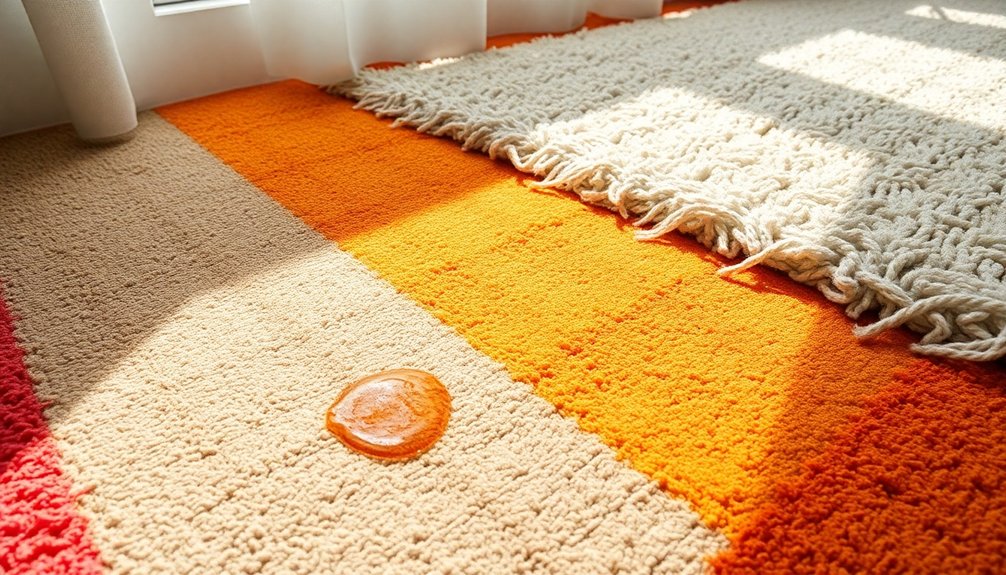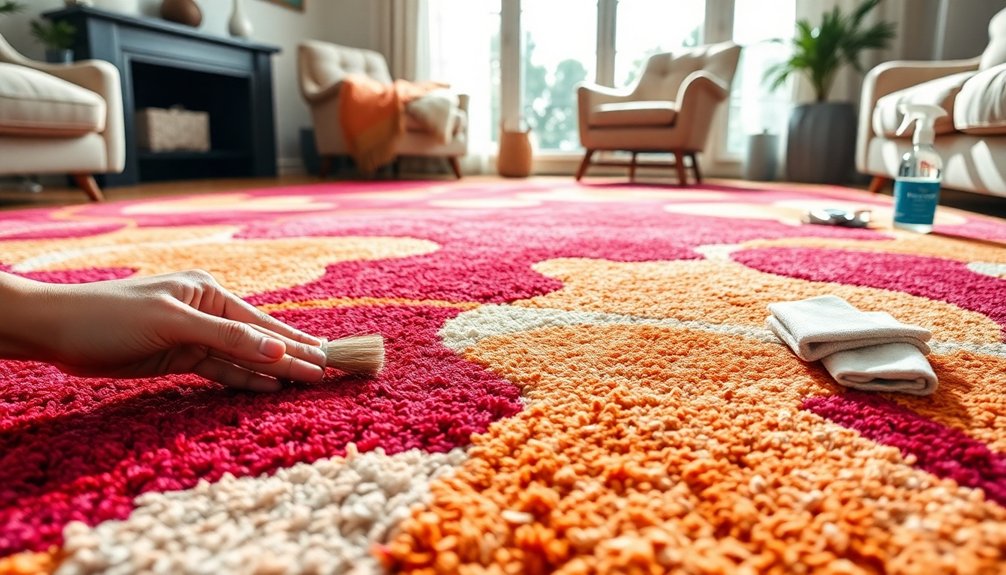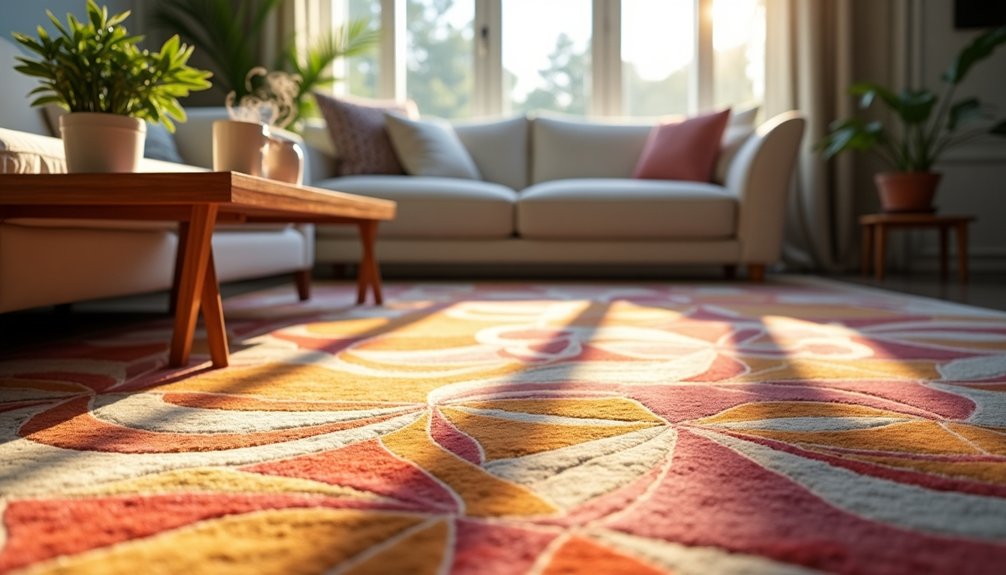Polypropylene rugs can be a smart choice for you, thanks to their durability and stain resistance, making them ideal for high-traffic areas. They offer a soft, plush feel and are lightweight, easy to clean, and available in various designs. However, they might not feel as comfortable as natural fibers and may wear out quicker over time. While they resist mold and mildew, be aware that they can struggle with oil stains and aren't biodegradable. Considering these factors can help you decide if they're right for your space, and more details can provide you greater insight into your options.
Key Takeaways
- Polypropylene rugs are durable and stain-resistant, making them ideal for high-traffic areas and easy to maintain with simple cleaning methods.
- They offer a wide range of colors and patterns, providing aesthetic versatility to match various decor styles.
- Lightweight and UV resistant, polypropylene rugs are suitable for both indoor and outdoor use, enhancing their versatility.
- However, they may feel less comfortable than natural fiber rugs and have a shorter lifespan due to susceptibility to wear.
- Environmental concerns arise from their non-biodegradable nature and potential release of harmful chemicals over time.
Overview of Polypropylene Rugs
Polypropylene rugs, often called olefin rugs, are made from synthetic fibers that deliver a soft, plush feel, rivaling natural materials like wool. Their design makes them an excellent choice for homeowners seeking affordable rug options without sacrificing comfort.
These rugs boast remarkable durability and stain-resistant properties, making them perfect for high-traffic areas. If you've got kids or pets running around, polypropylene rugs can handle spills and messes with ease.
One of the key advantages of polypropylene rugs is their aesthetic versatility. With a vast array of colors and patterns available, you can easily find a rug that complements your decor style, whether you prefer modern minimalism or classic designs.
Plus, these rugs are lightweight, which means you can effortlessly move them between indoor and outdoor spaces, where they can withstand UV resistance due to their polypropylene material.
When it comes to maintenance, you'll appreciate how easy they're to clean. A simple mix of soap and water is often all you need to keep your rug looking fresh.
Additionally, polypropylene rugs resist mold and mildew, providing a practical solution for various environments. Overall, these rugs combine functionality and style, making them a popular choice for many households.
Advantages of Polypropylene Rugs
When it comes to choosing a rug that combines practicality and style, polypropylene rugs stand out for several compelling reasons. First, they're incredibly stain resistant, making them ideal for high-traffic areas, especially in homes with children or pets. You can easily wipe off spills without leaving marks, ensuring your rug looks fresh and clean.
Additionally, polypropylene rugs are lightweight and easy to clean. A simple mix of soap and water is often all you need for maintenance, allowing for quick upkeep. This durability means they resist wear and tear, so you can enjoy their beauty over time without worrying about everyday use.
Their versatile design is another major advantage. With a wide range of colors and patterns available, you can find the perfect match for your interior style.
Furthermore, these rugs are hypoallergenic and resistant to mold and mildew, promoting a healthier indoor environment. This makes them particularly suitable for humid spaces where other materials might struggle.
Moreover, polypropylene rugs are made from non-toxic plastics, ensuring a safer and healthier environment for you and your family.
Disadvantages of Polypropylene Rugs

While many appreciate the practicality of polypropylene rugs, there are notable drawbacks to consider. Understanding these disadvantages of polypropylene rugs can help you make an informed choice for your space.
- Uncomfortable for Some Users: Polypropylene rugs lack the softness and luxurious feel of natural fibers, making them potentially uncomfortable, especially if you prefer plush textures underfoot.
- Vulnerable to Heat: These rugs are susceptible to heat and friction, which can cause them to melt or become damaged if placed near heaters or in direct sunlight.
- Limited Stain Resistance: Although they resist many stains, polypropylene rugs struggle with oil stains, which can be particularly difficult to clean and may leave lasting marks.
Additionally, the lifespan of polypropylene rugs tends to be shorter than that of natural fibers. Over time, they may show signs of wear and tear and struggle to recover from pressure and crushing.
Moreover, as a synthetic material, polypropylene rugs aren't biodegradable, raising environmental concerns regarding their production and disposal. Furthermore, polypropylene rugs contribute to the growing problem of plastic pollution in oceans and landfills, exacerbating the plastic waste crisis and disrupting ecosystems.
Comparison With Wool Rugs
Considering the disadvantages of polypropylene rugs, it's worth comparing them to wool rugs, which offer distinct advantages.
While polypropylene rugs are budget-friendly and stain-resistant, they often lack the softness and luxurious feel of wool rugs. Wool's inherent resilience makes it an ideal choice for high-traffic areas, as it can better withstand pressure and wear over time.
When it comes to durability and lifespan, wool rugs typically outlast their polypropylene counterparts.
While you might find polypropylene rugs easier to clean, wool rugs excel at hiding dirt, which can be a plus for busy households.
If you're looking for something that's not only beautiful but also eco-friendly, wool is a natural, biodegradable option, whereas polypropylene is synthetic and raises sustainability concerns.
Additionally, polypropylene rugs may release harmful chemicals over time, further contributing to their environmental drawbacks.
Maintenance and Care Tips

To keep your polypropylene rug looking fresh and vibrant, regular maintenance is key. Here are three essential tips to ensure your rug remains in excellent condition:
1. Vacuum Regularly: Make it a habit to vacuum your rug at least once a week. This removes dirt and debris, helping to maintain its appearance and extend its lifespan.
2. Address Spills Promptly: If you spill something, quickly scrape off any excess material and blot the area with a cloth. While polypropylene is stain-resistant, it's not completely stain-proof.
Using mild cleaning solutions, like soap and water, is often sufficient—avoid harsh chemicals as they can damage the fibers. For more stubborn stains, consider a bleach and water solution or another gentle cleaning method.
3. Schedule Professional Cleaning****: Aim for a thorough cleaning at least once a year, with professional cleaning every 12-18 months. This maintains optimal cleanliness and hygiene.
After cleaning, air drying is crucial to prevent water residue from damaging the rug.
Frequently Asked Questions
What Are the Disadvantages of Polypropylene Rugs?
When considering polypropylene rugs, you should be aware of their lower durability, sensitivity to heat, difficulty with oil stains, and potential off-gassing. These factors might affect your comfort and satisfaction in the long run.
Are Rugs Made of Polypropylene Good Quality?
Yes, rugs made of polypropylene can be of good quality. They're durable, stain-resistant, and easy to clean, making them practical for high-traffic areas. However, they might lack the luxurious feel of natural fiber rugs.
What Is the Lifespan of a Polypropylene Rug?
The lifespan of a polypropylene rug typically ranges from 5 to 10 years, depending on its quality and foot traffic. Regular vacuuming and spot cleaning can help you extend its durability and keep it looking fresh.
Can Dust Mites Live in Polypropylene Rugs?
Dust mites can't thrive in polypropylene rugs. Their non-porous fibers don't absorb moisture and don't provide food for mites, making your space less hospitable to allergens. Regular cleaning keeps them even more manageable.

